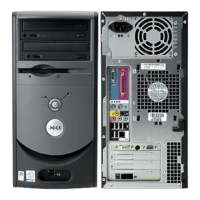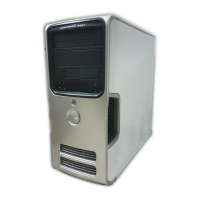System Memory Channel Mode
Displays the mode of your system memory.
Displays the amount of aperture memory. The default setting is 128 MB.
The processor speed at which the computer boots.
Press the left- or right-arrow key to toggle the CPU Speed option between the resident processor's rated speed (the default speed) and a
lower-compatibility speed. A change to this option takes effect immediately and no restart is necessary.
To toggle between the rated processor speed and the compatibility speed while the computer is running in real mode, press
<Ctrl><Alt><\>. (For keyboards that do not use American English, press <Ctrl><Alt><#>.)
The speed of the processor's system bus.
The manufacturer's identification code(s) for the installed processor.
The core speed at which the processor(s) can operate.
The size of the processor's L2 cache.
The setting that allows you to enables or disable Hyper-Threading technology for operating systems that support Hyper-Threading. The
default setting is Disabled.
NOTE: If your computer has a processor capable of supporting Hyper-Threading, the Hyper-Threading option is the first selection in the list.
Integrated Devices (Legacy Select Options)
Configures the following devices integrated with the system board:
The settings are On (default) or Off.
Network Interface
Controller
The settings are On (default), Off, or On w/ PXE.
The settings are On or Off.
The settings are On (default) and Off.
The settings are On (default) or Off.
The settings are Enabled (default) and Disabled.
Serial Port 1 and
Serial Port 2
The settings are Off and Auto (default). (Serial Port 2 appears as an option if you have a serial port card installed.)
Auto automatically configures a connector to a particular designation (COM1 or COM3 for Serial Port 1; COM2 or COM4 for Serial
Port 2).
If you set a serial connector to Auto and then add a card that is also set to Auto, the computer automatically remaps the integrated
port to the next available connector designation that shares the same IRQ setting as follows:
l COM1 (I/O address 3F8h), which shares IRQ4 with COM3, is remapped to COM3 (I/O address 3E8h).
l COM2 (I/O address 2F8h), which shares IRQ3 with COM4, is remapped to COM4 (I/O address 2E8h).
NOTE: When two COM connectors share an IRQ setting, you can use either connector as necessary, but you may not be able to use
both connectors at the same time.
The settings are Mode, I/O Address, and DMA Channel:
l Mode settings are PS/2 (default), EPP, ECP, AT, or Off. Set the Mode option according to the type of device connected to the
parallel connector. To determine the correct mode to use, see the documentation that came with the device.
l I/O Address settings are 378h (default), 278h, or 3BCh. The settings are not available when Mode is set to Off.
NOTE: You cannot set the parallel connector to 3BCh if Mode is set to EPP.
l DMA Channel appears only when Mode is set to ECP. Settings are DMA 1, DMA 3, or Off.
The settings are Off and Auto (default).
Auto turns off the IDE interface (when necessary) to accommodate a controller card installed in an expansion slot.
The settings are Auto (default), Read Only, and Off.
l Auto turns off the integrated floppy drive controller when necessary to accommodate a controller card installed in an
expansion slot.
l Read Only prevents the computer's integrated floppy drive controller from writing to floppy drives and also activates the Auto
setting.
The settings are On (default) and Off.
Primary Video
Controller
The settings are Auto (default) and Onboard.
l Auto (default) — If only an AGP card is installed, the computer uses the AGP card; if only a PCI card is installed, the computer
uses the PCI card; if both AGP and PCI cards are installed, the computer uses both cards.
l Onboard — The computer uses the AGP card.
The settings are 1 MB (default) and 8 MB.

